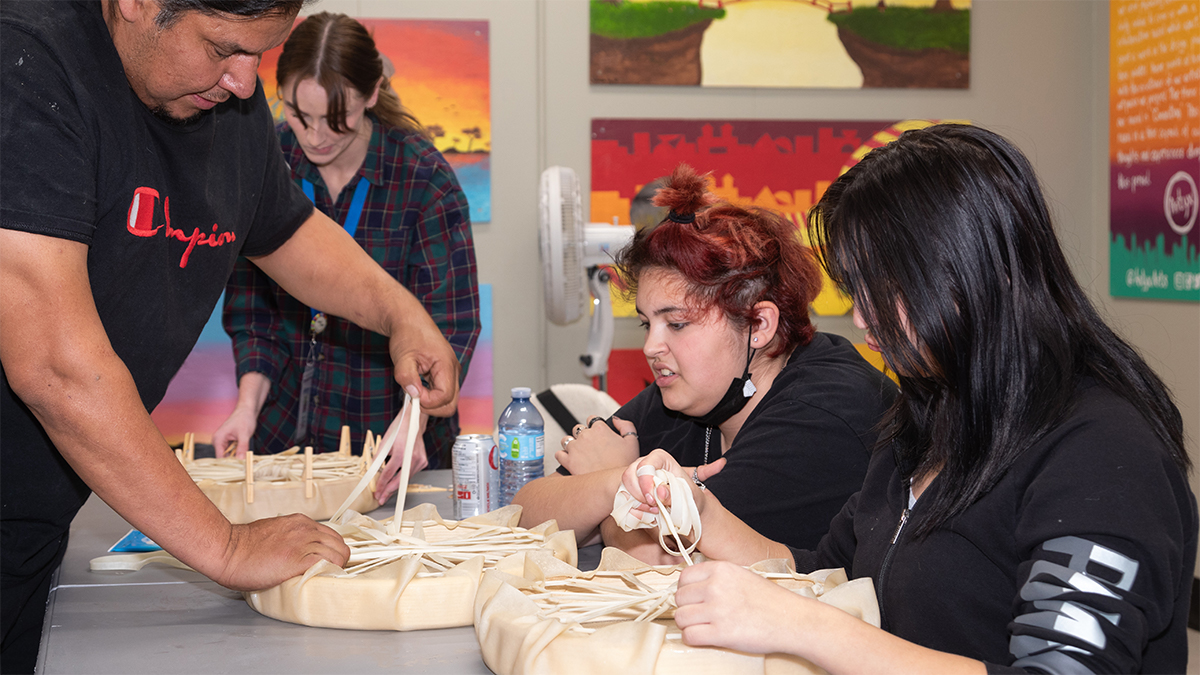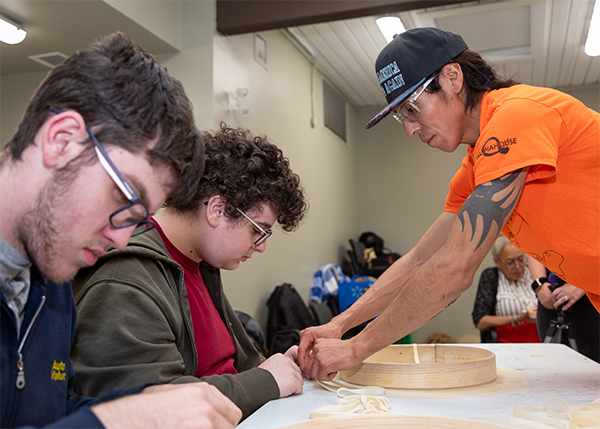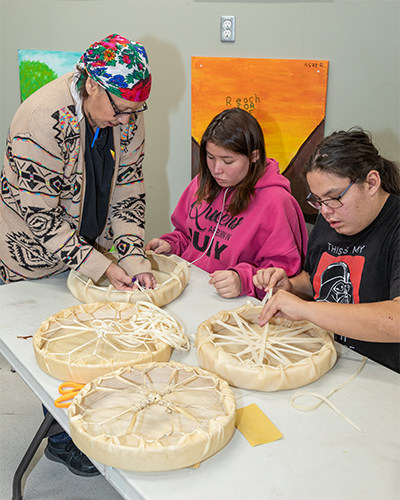The heart and the drum beat as one

Strong cultural ties bring healing to Indigenous Calgarians
On a November evening at the Forest Lawn Activity Centre, a room teems with Indigenous youth, numerous volunteers, and an Indigenous Elder. Workshop leader Sonny Campbell quiets the room by explaining the significance of the raw materials laid on tables in front of nine attentive students. Each place is laid with a round of damp deer hide, a white ash hoop, long lengths of rawhide lacing, a sturdy wooden stick, and a square of bronzed leather. Once assembled, the drum acts as a sacred tool to bridge the divide between the spirit and earth worlds.
“The spirit of animal is in the hide and comes dancing while we’re singing; it will be running around us, calling the Spirits in,” explains Sonny. “When the song is done, the hide of the drum, the ring from the tree, delivers the message for what you are asking for in the song – protection, prayer. When you weave the lacing on the back of your drum, it represents how every living thing is connected to the Creator and we are one. The circle of the drum shows how no one is in front or behind, no one is above or below, but we are all together.”
The City-subsidized drum making workshops, amongst others, are organized by Flora Johnson, one of three Indigenous Community Connectors that are part of the Community Hubs Initiative. She works in the Greater Forest Lawn Community Hub. The Community Hubs Initiative is a partnership between The City of Calgary and United Way of Calgary. Flora, a Sixties Scoop survivor and Forest Lawn resident, is an artist and maker, eager to share her gifts and experiences with others so Indigenous stories and culture are not lost and can be passed down through the generations.
“These youth workshops are amazing. We haven’t really promoted our workshops publicly and they are already full,” says Flora. “There is a lot of laughter and when I see their eyes light up, they walk away with more knowledge and I hope confidence and pride in their culture. I want them to have the strength that I found during the trauma I experienced. To not live in fear, but to do things that make them feel happy and connected.”
Community Hubs like the one in Forest Lawn are places where residents can connect to their neighbours, increase their leadership skills, and access a variety of supports and services right in their own backyard. Working alongside residents and partners, Community Social Workers identify barriers and opportunities for residents to participate in community life and the hub reflects and strengthens the unique fabric of each neighbourhood. A large Indigenous population resides in the Greater Forest Lawn Area, so the hub need was identified to create a place that’s welcoming, inclusive and connecting, one where people could connect on the spectrum of their healing journey. The community created a sacred medicinal garden, and having a dedicated space to develop and implement wellness, culture, and language initiatives led by community leaders like Sonny and Flora has made all the difference.
“It is kind of hard to explain how culture can help achieve wellness, but it does,” says Flora. “Sometimes if something big is happening in your life, it is just sitting quietly and listening to the drum. It just feels safe and comforting. Things feel brighter and lighter.”
“Indigenous People from all over Canada come to Calgary for many reasons; there’s a lot of opportunity here,” continues Flora. “But we know when we travel, you can go to the reserves, no matter where they are located, and feel like it is home, and you can always feel connected. It is harder in a big city like Calgary where Indigenous People may feel alone, with nobody to talk to, nobody to share the kind of activities we do. It makes me fight even harder for our culture, because if you're Blackfoot, Cree, Dene, Inuit, Metis, it doesn't matter, we still have that connection.”
Fifteen-year-old Jayden, who goes to school in Forest Lawn, attended the workshop with her sister Niya.
“I’m not really like entirely into my culture, at least not as much as I’d like to be,” explains Jayden. “Getting to do this workshop is pretty cool. I’m not really immersed in it, and there isn’t much opportunity to connect. We had a great conversation in my class about culture and identity. How identity is important to everyone’s individual self, and being raised around your culture can help you grow up with morals and stability. It can provide you comfort, much like a safety net, and something that gives you a part of yourself. So, getting to do this, allows me to understand myself more while learning more about my culture.”
Jayden says that up until her family made the move to Forest Lawn, where there is a larger Indigenous population, she really didn’t know a lot about her Indigenous culture.
“Neither of us knew how to smudge, I didn’t know what to do and I was very nervous. Now as we’ve grown up here, it’s really cool to see more of our culture accepted and represented. It’s cool to hear the language all of a sudden and I can use words like ‘kookum’ and ‘mushum’ (grandmother and grandfather in Cree) when talking about my grandparents and I don’t have to feel embarrassed or ashamed. I like getting to hear and use my own language.”
Sixteen-year-old Quentin and his brother Tristan attended after their mother learned about the workshop from Flora. Quentin says he felt comfortable to join the workshop as he is familiar with Flora’s program offerings through the Community Hub. He is appreciative of opportunities to connect with his Indigenous heritage.
“It’s really important. I live in the city so there is a disconnect with our culture, being around so many other cultures, and not being able to be out on the land,” he says. “Coming to these events makes me feel more fulfilled. My mom talks a lot about not being able to be connected to her culture throughout her life; her dad was ashamed to be Indigenous because of the residential school system. Seeing how much my mom has been impacted by not being able to learn her culture has helped me seek it out more and really want to be here.”
Flora is inspired and hopeful, and strengthened with more funding, feels she can continue to share Indigenous culture, break down barriers between different cultures, reduce shame and stigma, and bring healing to Indigenous People from all Nations. She says the trauma she experienced helped her appreciate the things that are important, and to her, it's about giving back to the community, giving back to the people.
“As a dedicated Indigenous Community Connector, I see youth really wanting to learn and know their culture as it is healing,” says Flora. “They want to take their culture back, and for me, that gives me peace of mind. This is who I am. This is my path. This is my journey. This is my connection.”

Greater Forest Lawn Community Hub
The Greater Forest Lawn Community Hub is a project supported by The City of Calgary in support of the Enough For All strategy, The United Way of Calgary and Area, with Rotary Clubs of Calgary as a founding partner. Community Hubs are welcoming and inclusive spaces where residents build connections, access supports and services, and work together to identify and respond to community needs, all of which contribute to stronger neighbourhoods.

QuentinI’m very proud of my Indigenous heritage and I want to learn everything I can about my culture throughout my life, especially knowing that a lot of people weren’t able to.
Categories: Community, Indigenous

